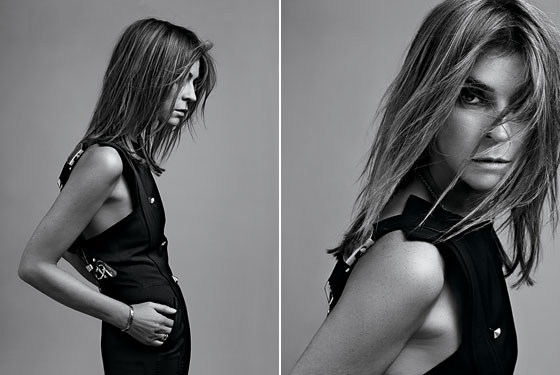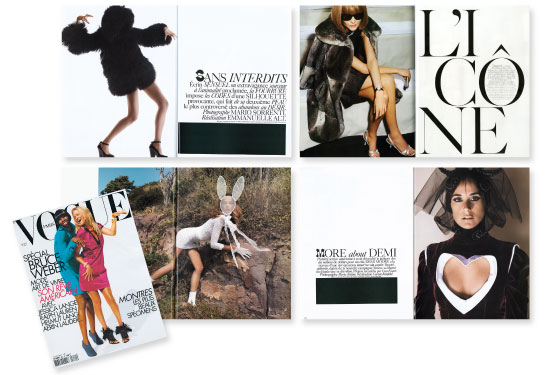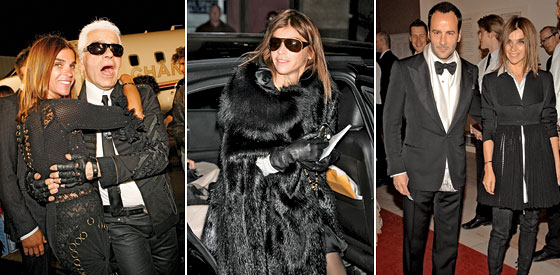
When Carine Roitfeld, the editor of French Vogue, styles a fashion shoot, she does not start with the clothes. She looks first at the model and comes up with a story: Perhaps this girl has married young and taken a lover. Perhaps she married young, has taken three lovers, and is about to go to Brazil. Perhaps she lives in London and is bored to death with mad cow disease and wants desperately to eat a great, juicy piece of steak. “I do a movie in my mind,” she says. “Who is this girl?”
One cold, bright December morning, her own story is this: She is a fiftyish woman having a double espresso in the lobby of the Carlyle on Madison Avenue. “For me, it is best to be the youngest in hotel,” she explains, “and I was not having this feeling at the Mercer.” She has come to New York for her son Vladimir’s 23rd birthday, which she celebrated the night before with dinner at Indochine. “It makes me happy because there is vewy gweat lighting,” she says about the restaurant. “Vewy flatter.” (Roitfeld has reached a compromise with the hard American r by converting them all to ws.)
She was especially pleased with the lighting because of a disfiguring recent visit to the dermatologist. “I am monster,” she explains, gesturing at an infinitesimal dot on her nose.
Roitfeld has slid out of a fluffy paneled Tom Ford fur cape, and it is gathered at her waist, her impossibly skinny body sticking out of each side. Her eyebrows are thick and dark, her hair is surprisingly blonde—“I follow an advice of Tom Ford: When you get older, you have to get blonder. It is my surfer look.”
In the story she comes up with for herself, it is her ambition to look like the subject of a Helmut Newton photograph, and she does, in a way: She sort of exists in black-and-white, and her clothes often bear straps and buckles, a very light fashion bondage. She also looks, as has often been pointed out, quite a lot like Iggy Pop.
But she does not think much about her influences. “Some editors, they have that, they know all the designer from the beginning of the nineteenth century. They know this is triple cashmere, this is simple cashmere. Maybe they went to fashion school. Me, I don’t. I just get a feeling about what is exciting. It is all just from feeling. So I don’t know”—she pulls her lips into a pout and gives one of those poufy little French exhales—“I think maybe I have a talent.”
Roitfeld has been the editor-in-chief of French Vogue for the past seven years, ever since she took over from the cerebral Joan Juliet Buck. Roitfeld remade French Vogue in her own image, which is to say svelte, tough, luxurious, and wholeheartedly in love with dangling-cigarette, bare-chested fashion. French Vogue is now internationally major, to use an industry expression, with an influence that transcends its tiny (133,000) circulation.
So much of the fashion world is about negotiating insecurity—exploiting it enough to make you want to buy things, but still nurturing, to keep you close. But Carine Roitfeld is like the industry’s X factor: Fashion does not, could not, make her insecure. Fashion is the place in the world where Roitfeld is most comfortable and at home.
Because of this, Roitfeld’s French Vogue is the polar opposite of most American fashion magazines. It is unconcerned with making fashion wearable or accessible to its readers. It is not inclusive: There is no advice on how to dress if you’re shaped like a pear or about to turn 50.
In Roitfeld’s world, models are never too skinny, diamonds are never too expensive. Covers are not devoted to whichever film star has a blockbuster to promote, but primarily to models—when Roitfeld and Bruce Weber happened upon (former “Look Book” subject) André J., a black transvestite with an Afro, incredible legs, and an Amish-style chinstrap beard, they put him in a minidress and on the cover.
French Vogue assumes membership in a club that treats fashion unapologetically. Guest editorships are given to cool girls of the moment (Kate Moss, Sofia Coppola, Charlotte Gainsbourg), who post endless photos of themselves and their skinny friends and the details of their lives—lives in which such mundanities as medicine cabinets and grocery lists are shown to be far more glamorous than your own. The scrappy documentary photography of these features only underlines how naturally cool such people are: Their glamour is presented as something that doesn’t need the aid of stylists and special lighting. It is innate.
When French Vogue cover girls aren’t models, they needn’t be typically pretty. Gainsbourg, for example, is somewhat jolie laide, with a long, narrow face and sad eyes. She looks fantastic wearing the Japanese avant-garde, which is not something that can be said for, say, Kate Bosworth.

“The American editors are very, how you say, slick,” Roitfeld says. “Very perfect. Hair is perfect, they have a manicure. They are very clean, they follow fashion. I don’t think they take many risks. They do the total look of Prada. Me, I wear a lot of Japanese piece mixed with a bit of classic Hermès and Prada. Even though jeans suit me, I never wear jeans.”
Roitfeld herself styles many of her magazine’s sittings. “I love the combination of a masculine piece with a feminine piece. It’s very French, it’s very sexy. It’s my culture. It’s the way I was raised.”
The party pages at the back of the magazine are clogged with photos of French Vogue staffers, mostly Roitfeld herself, often with her daughter, Julia. She claims to have mixed feelings about the exposure. “It’s very difficult not to become a puppet,” she says of it all. “Like Anna, she becomes so iconic that she becomes like a puppet. I don’t want to be like that, I don’t want to wear this uniform, I don’t want to be just an envelope.”
Roitfeld styled a shoot last year in homage to Wintour’s look, puppetlike or not, starring a model with a bob, dark sunglasses, and many a fur coat. (“PETA, they like to pay attention to her, not to me,” she says, “so this is good for me.”)
Speculation about Roitfeld’s coming to America to helm a great American title (Bazaar, Vogue) is endless—not least because of the Devil Wears Prada plotline in which Machiavellian Miranda is temporarily ditched for Jacqueline Follet, who is sleeker and more laid-back.
In reality, it’s hard to imagine Roitfeld running a big, corporate American magazine. She is free to be the Rizzo to America’s Sandy because French Vogue is so small—and it’s a role that suits her. American Vogue has a circulation of 1.3 million, and it is a huge business, a massively lucrative brand, starring triple-A-list actresses, glossy socialites, and, of course, models. But part of becoming the editor of a big American magazine is wanting it, and Roitfeld does not. “My best quality is to be stylist. I never think about this career, this big job,” she says. “I never wanted to be what I am today, and I will not die in the position.” She still finds the idea of an office with a door where she’s expected every day (at least by telephone) somewhat troubling. All she ever wanted was to be surrounded by very attractive people and very expensive clothes. It’s always been “fashion, fashion, fashion”—so much so that she lists beauty and jewelry as evidence that the job as editor-in-chief has expanded her range of interests.
And she doesn’t care much for the business aspect of fashion. In an industry where accessories count for the bulk of her advertisers’ revenue, she has this to say: “Right now I think that fashion in the world becomes a bit boring. There is so much money, and I feel a bit when you go to shows they want to sell so many handbags, and for me, well, I do not like handbags. I do not wear handbags. It is not a nice look, to carry a handbag.”
“I’m not a business girl,” Roitfeld says. “I will never be a business girl, but I will say, for Anna Wintour, that I respect successful people, I like things that are success. But this is really American.”
Roitfeld got her start at French Elle as a teenager in the late seventies, basically dissecting her own look for readers. But it was not until the nineties that the look developed by Carine Roitfeld, executed by Tom Ford, and photographed by Mario Testino went global. Tom Ford, her longtime collaborator, took over first at Gucci and later at Yves Saint Laurent as well, and brought Roitfeld along as his muse.
It was the best job she ever had. “I was not checking the materials or something,” she says. “I was just looking the way I was looking, sitting the way I was sitting. Making the girls look like me; it was an easy job.”
The way she was sitting and looking begins with her hair, which has always been pin-straight and razor-sharp and kind of in her face. Her eyes, which are always rimmed in kohl pencil (she does not wear lipstick), peer out melodramatically from behind it all.
And then there are the clothes, which are every bit as sharp as that hair. They are well-tailored and unafraid of sex. They are not nostalgic, or sentimental, or romantic, or pretty. They do not dabble in haute bohemia or the intellectual frump of recent fashion. They are harsh and clean and always, always, worn with a stiletto heel. Roitfeld herself says it is “very sexy, but very woman, and always some rock and roll, eh?”

The stiletto-mania of the nineties owes as much to Carine Roitfeld as it does to Candace Bushnell. “I do not like comfortable,” Roitfeld says. She has outlawed sneakers and what she calls “Hugg boots” in her office because “they are hugly.” The line Roitfeld has always been best at navigating is the line between provocative and vulgar.
When Ford left Gucci, Roitfeld moved on to Missoni, which had always been fairly staid. Its knits were the stuff of Italian women with matching orange skin and hair. In Roitfeld’s hands, the knits became clingy and suggestive. “I like not to shock,” she says, “but there must be a bit of provocation. The girl can never be with bruise or violence, but there must be sex.” Missoni suddenly was hot. And then Condé Nast came calling.
Roitfeld has lived her whole life in Paris. Her father was a white-Russian émigré and producer of films like The Count of Monte Cristo. He was also her hero. “Women, they want to sleep with him; men, they want to be him,” she says, “that kind of thing.” Her mother, who is still alive, was classic Parisian—B.C.B.G., which means bon chic, bon genre—tidy little suits and an Hermès fetish. Not, in the end, Roitfeld’s thing. “My mom read French Elle when I was a little girl, and so, when I was 15 or 16, I said, I want to work in fashion. I didn’t stay to do studies, I became a model instead. Not a top model, just a model, but it made me a foot in that business.”
She met her husband, Christian Restoin (who is not, technically, her husband, but never mind), after she used some of the shirts he was manufacturing for a label called Equipment in a photo shoot. They have two children together: Julia, a New York socialite and graphic designer, and Vladimir, who just graduated from USC and lives in New York. They are, by all accounts, an extremely close family. When Roitfeld got the French Vogue job, Restoin closed Equipment. “For 30 years, I support him in the big job,” she says. “And now he support me.”
“Anna,” says Roitfeld, “becomes so iconic that she becomes like a puppet. I don’t want to be like that. I don’t want to wear this uniform. I don’t want to be just an envelope.”
“They are,” Roitfeld says of her family, “why I am so down-to-earth. They keep me very ground.”
Her closest friends are, naturally, in the business: “I mix everything,” she says. “My photographer is the godfather of my kids. I don’t separate; for me, it is impossible. I don’t know if it’s good, my way of working, but it is only what is possible for me.”
Roitfeld finishes her espresso and gathers herself up to leave, swaddling herself in that great piece of fur, but suddenly she looks panicked. “One thing,” she says. “I have in my office—what you call in America? Something to weigh?”
A scale?
“A scale. So people always say that I weigh my staff, and it is totally wrong. All my girls are very skinny and very chic and very beautiful. And if they are not beautiful, well, then they are very charming. So people always say that I weigh them, but no. I don’t weigh my girls.”
The French Vogue offices are on the Rue du Faubourg St.-Honoré, which is the street in Paris with the highest density of super-fancy shops: It’s only steps to the Hermès flagship, and also to Lanvin. The office building itself is unremarkable, but it is right behind the Hôtel de Crillon, which is where Roitfeld takes her meetings if her office is “too mess.” The Vogue floor is the usual warren of small, cubelike offices, which gives way to the chalky white box where Roitfeld sits behind a glass-topped desk, her legs all coiled around one another.
“Doesn’t she look like Nicole Kidman?” Roitfeld says of the assistant posted at her door. “I told you, all the girl who work at French Vogue are vewy skinny and beautiful.”
Roitfeld’s office is entirely, almost clinically white, as if awaiting furniture or paint. The only decoration is a six-foot-square close-up of her face as photographed by Karl Lagerfeld. Rows of white bookshelves are empty, with the exception of a diamanté skull, a three-volume dictionary of Chinese characters, and two creepy masks, which Roitfeld explains celebrate the Day of the Dead. “I love skulls,” she says.
“It’s the same as in my home,” Roitfeld says. “I like clean, clean, clean, clean. It’s my new Zen attitude, you know? The less you have, the more you enjoy.”
Her desk is nearly empty—Roitfeld does not know how to use a computer—save for a telephone, a pair of black suede gloves, some color printouts of a fashion shoot, and a tiny snakeskin clutch.
It is January 8. President Nicolas Sarkozy of France has just delivered his New Year’s address, and Paris is agape about his relationship with Carla Bruni. But as for Bruni, she has this to say: “For us it is good. She is very glamour. She can fit in the clothes.
“We are very happy.”
She is upset about the smoking ban, which went into effect on the first of the year—she does not smoke, but Christian does. And she likes the smell.
Today, Roitfeld is wearing a narrow leather skirt and a double-breasted black blazer with sharp shoulders and lapels. She is also wearing black stockings and, of course, extremely tall, extremely narrow high heels. Her hands are wrapped around a steaming silver mug out of which a label dangles: Yogi Tea. Roitfeld is 48 hours off a ten-day vacation in Thailand during which she worked a great deal on meditation.
How was this trip?
“You think this will be so glamorous,” she sighs. “You have the idea in your mind and then you get there and the people in the hotel …” She grimaces and gestures hugely in the hip area. “There were lots of people who were so fat and like that.”
Kate Moss did come to visit, which helped with the glamour, and Roitfeld did, she is pleased to report, manage to unwind, somewhat. But still, Roitfeld struggles daily with a certain agita.
“I love pills. I cannot sleep, so I love pills.”
Every day she takes a combination of anti-anxiety drugs to help keep her calm and to help her sleep, but still, she practically vibrates with energy. “My doctor, he tells me that I begin to lose my vision because of the pills.”
Roitfeld shrugs. In the movie of her life, what happens, happens. Just a feeling. She will leave the next day for Testino’s studio in London, but first she will go home. Her daily commute leads through the Place de la Concorde, past the Grand and Petit Palais, and deposits her on her doorstep just off the Place des Invalides. “So you see,” she says, “every day I see the most beautiful place in the world. It is not too bad.”